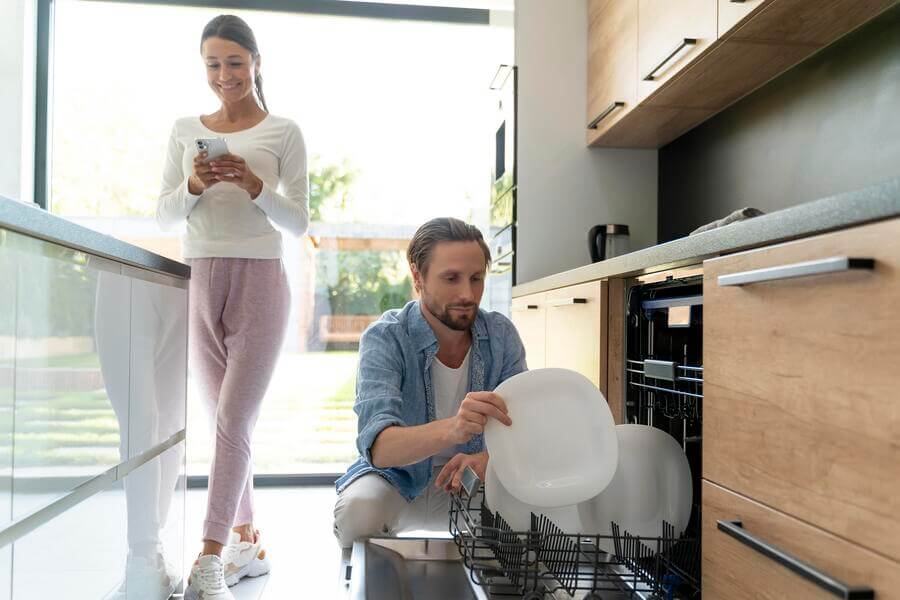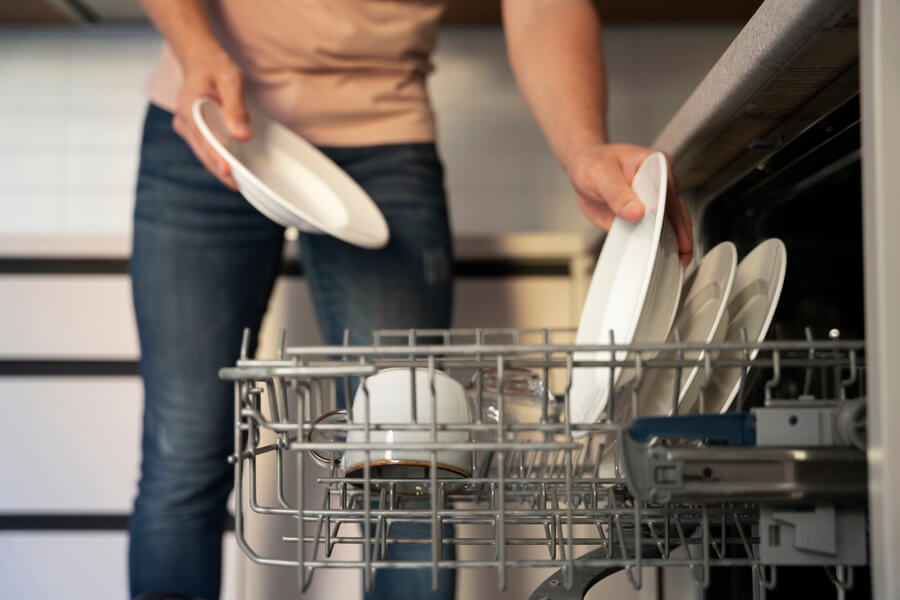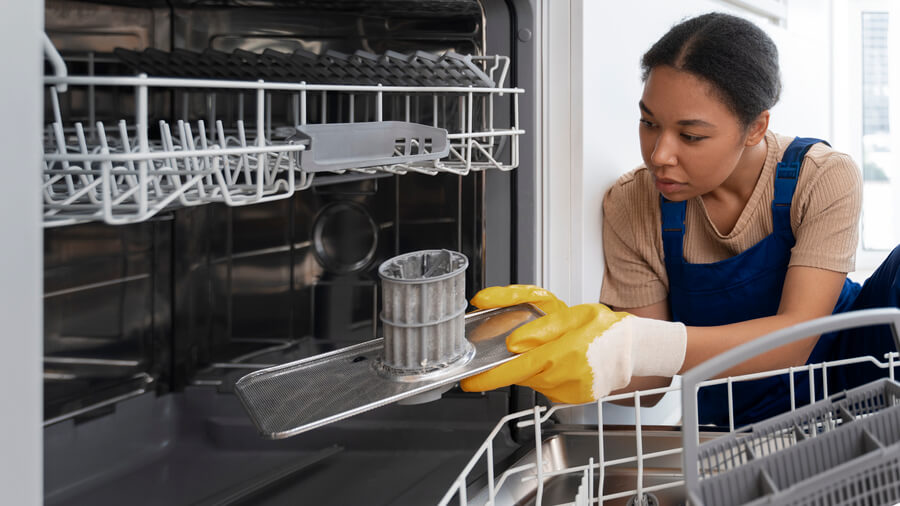Dishwashers allow you to clean dishes with ease and much-needed convenience. You need to feed the unit with water and soap, and you are good to go.

Unfortunately, due to blockage and other technical issues, it may sometimes start and stop immediately. This article looks at the causes and how you can fix the problem.
Check for Blocked Spray Arms
If your dishwasher starts and then stops immediately, chances are the spray arms are blocked. Spray arms are responsible for distributing water when cleaning your dishes. They can be clogged with small debris and food particles, hampering the functionality of the dishwasher.
How To Clean Spray Arms
- For safety, turn off the dishwasher to avoid electrocution.
- Remove the lower rack to access the lower spray arm.
- Locate the bolts or screws holding the spray arm. Remove them using a screwdriver and gently remove the spray arm.
- Fill a bucket with hot water and add soap and vinegar, making sure to mix correctly.
- Insert the spray arm into the mixture for a few minutes. Once the debris becomes loose, clean it with a soft cloth. You may also use a soft toothbrush to clean out the nozzles and the inside of the spray arm.
- If you cannot remove the arm or do not have screws, dip the soft cloth in the soapy water and use a spray bottle to re-soak the cloth after 10 minutes until the debris becomes loose.
- If your model has an upper arm, follow the same procedure to examine and clean it. All you need is to remove the upper rack to access it.
- Once the arms are clean, reinstall them, ensuring a tight fit.
- Some models come with a filter. If yours has one, you can clean it if it is clogged.
- Once you reattach the filter, run a test cycle to ensure the dishwasher works correctly.

Examine The Door Latch
A faulty door latch that does not close properly can also cause your dishwasher to start and then stop immediately. There are many reasons, such as a misaligned dishwasher, dirty door latch, and protruding racks. To fix this issue, you can follow these steps.
How To Repair A Door Latch
- For safety, make sure to disconnect the dishwasher from the power source.
- Examine the latch to identify the cause of the problem. This could be a misalignment, blockage, or a damaged latch.
- Clean the door latch, removing any visible obstruction if it is dirty. Accumulation of dirt and food particles may cause the door latch not to close correctly.
- Check whether the door is aligned correctly. If not, push or pull gently to align it with the frame. You may need to tighten or loosen the hinges.
- Tighten the screws that hold the door latch in place. Loose screws might cause the door latch not to close correctly.
- Check for any visible damage, such as cracks. A damaged door latch will need replacement. Order a replacement latch from the manufacturer or third-party vendor.
- Remove the screws holding the old latch in place and disconnect any wires.
- Install the new latch in the same position, connect the wires, and tighten the screws to hold it in place.
- Check whether the strike plate is misaligned. If so, loosen the screws holding it to the dishwasher’s frame and adjust its position. Finally, tighten the screws.
- Inspect the door gasket for damages. If worn out, replace it with a new one.
- After making the repairs and adjustments, connect the dishwasher to the power source. Test whether the door latch is working correctly.
Examine The Float Switch
A float switch measures the water level in a dishwasher. Located at the bottom of the unit, it turns off the water before it overflows. If faulty, it might cause water to overflow, causing the dishwasher to not operate correctly, such as starting and stopping immediately. To fix this issue, follow these steps.
How To Examine And Replace A Float Switch
- Make sure to disconnect the dishwasher from the power supply before replacing it.
- Access the float switch. It is located at the bottom of the dishwasher. All you need to do is remove the lower access panel. However, this might vary depending on the model of the unit.
- Inspect the float assembly for any obstructions, damage, or debris. A float assembly moves up and down as the water levels rise or lower in the washer. Refer to the user manual for the specific location.
- If there’s obstruction, use a brush or cloth to remove the debris.
- Examine the float switch using a multimeter—the multimeter checks for continuity, testing the current and resistance. If the float is in the down position, there should be continuity. When in the up position, there should be no continuity.
- If the float switch is faulty, replace it with a new one. Order the replacement switch from the dishwasher’s manufacturer.
- Disconnect the wires to the old float switch while noting how the cables are connected.
- Unscrew the screws holding the float switch in place.
- Install the new switch in the exact location and connect the wires to the correct terminals.
- Fasten the screws to hold it in place.
- After replacing the float switch, reconnect the dishwasher to the power source and run a test cycle.
If you cannot replace the switch, you can consult a technician.
Clean The Filter

A clogged filter can cause your dishwasher to start and then stop immediately. This could be due to food particles or debris. Fortunately, cleaning the dishwasher filter is straightforward. All you need is soapy water and a soft cloth, and you are good to go.
How To Clean Your Dishwasher Filter
- Make sure the dishwasher is disconnected from the power source.
- Access the filter. The dishwasher filter is located at the bottom. You can access it by removing the bottom dish rack. Some filters might be beneath the sprayer arm or at the back corner of the washer.
- Modern dishwashers come with two filters: the upper and lower filter. Start with the upper filter. Turn it clockwise to make it loose, and gently remove it.
- Remove the lower filter by pulling it straight out.
- Clean the two filters with a soft brush in a bucket or kitchen sink. For best results, use hot water and a soap dish.
- Once you’ve removed all debris and food particles, run water through the filters to test their cleanliness. If the water is clear, it indicates the filters are clean.
- With the filters clean, wipe around where they sit.
- Reinstall the lower filter to its rightful position, ensuring it aligns with the drainage hole.
- Reinstall the upper filter, turning it anticlockwise for a secure fit.
- Now, test your dishwasher to see if it is working correctly.
Final Thoughts
While the dishwasher starting and stopping immediately can be due to technical issues, often it is due to clogged filters and spray arms. Fortunately, addressing this is as easy as cleaning the components and filters with a soft brush. We recommend consulting a certified technician to help solve the technical aspect.
